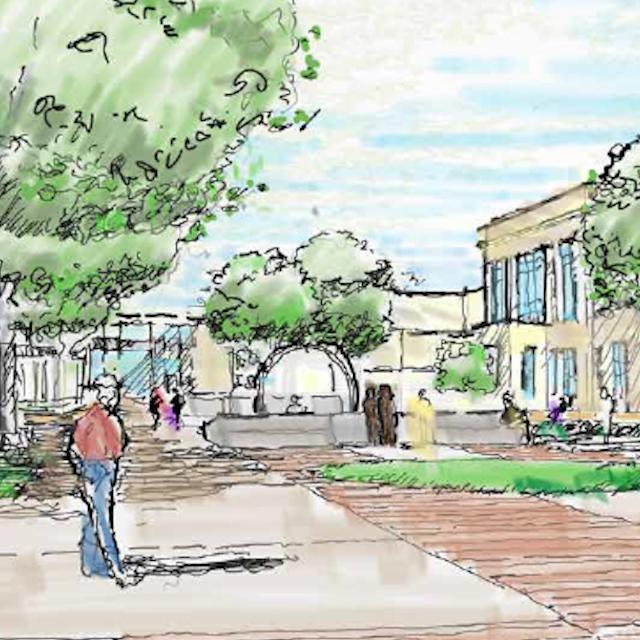
New Plaza to Honor TCU’s Past, Present, Future
The past, present and future of TCU will be on display for all to see in the campus’s
new Sesquicentennial Plaza, located in the Academic Commons. An artist has been commissioned
to develop three arches representing the three time periods. The project will incorporate
new work, as well as the existing statue of founders Addison and Randolph Clark.
The landmark statue – commissioned in 1993 and visible east of University Drive –
will be integrated into the plans and repositioned at ground level, representing TCU’s
history.
“We wanted the plaza to capture more stories that may not be familiar to everyone,” explained Aisha Torrey-Sawyer, director for TCU’s Center for Connection Culture
and one of the plaza’s committee members. “Conceptually, we wanted the past, present
and future depicted with the architecture of three arches.”
The new plaza will include benches and landscaping to provide a key gathering place
on campus. Completion of the plaza is expected in fall 2025, with installation of
the arches to follow shortly after when design is complete.
With the Clark Brothers statue helping to represent TCU’s past, the arch representing
TCU’s present will recognize the leadership donors that supported TCU during Lead
On: A Campaign for TCU, the university’s historic $1 billion campaign.
“The pivotal support of our generous donors has brought TCU where we are today,” said
Julie Whitt, associate vice chancellor for donor relations and another of the plaza’s
committee members. “Our donors are helping shape TCU’s legacy. Inscribing their names
on our new landmark is an enduring testament to how far we’ve come and where we are
headed.”
The $1.8 million project was completely donor-funded, thanks to the generosity of
TCU Trustee Eddie Clark and wife Pam as lead donors. Other project donors include
Trustee Anita Cox and Trustee Emeritus Kelly Cox; Trustee Neils Agather and wife Elaine;
Trustee Amy Roach Bailey and husband Tull; and Trustee Rick Wittenbraker and wife
Connie.
The remaining portion representing TCU’s future will reflect the impact and contribution
that TCU graduates will provide because of the university’s community, scholarship
and innovation, explained Jason Soileau, assistant vice chancellor for planning, design
and construction.
The artist is James Peterson of Los Angeles. Soileau said the site will include architectural
concrete, new seating and the arch sculptures, which are expected to be constructed
out of bronze or other metal.
The plaza project is part of TCU’s broader master plan, Soileau said, particularly
with the goal to create more green space and support a walkable campus.
“This is intended to strengthen the TCU campus in ways that facilitate community,
collaboration and connection within the physical campus,” he said. “This project reflects
on TCU’s rich history while celebrating the tremendous opportunity that lies ahead
for our growing university.”
The plaza committee’s work began as part of TCU’s Race & Reconciliation Initiative,
which included a survey of the artwork and imagery around campus, examining those
that might have been affiliated with the Confederacy.
While Addison Clark was in the Confederate army, the committee determined that the
statue was erected to honor and recognize the brothers as the university’s founders
and had no direct connection to the Confederacy.
The committee’s idea for the plaza grew from RRI’s recommendation to tell TCU’s full
history, one that provides more robust contextual information and memorializes a more
complete story of TCU.
“We set out to make a centerpiece on campus for years to come that will help people
learn all aspects of TCU’s history,” Torrey-Sawyer said. “The future arch is about what we want TCU to be for the next
150 years.”
In her 24 years at TCU, she said, this has been her favorite endeavor.
“It’s about informing, educating and telling stories of those who are often overlooked,”
Torrey-Sawyer said, “and it’s become a beautiful art project with lasting impact.”
